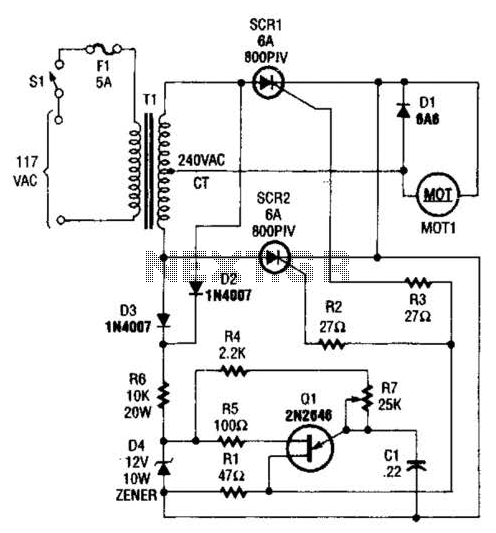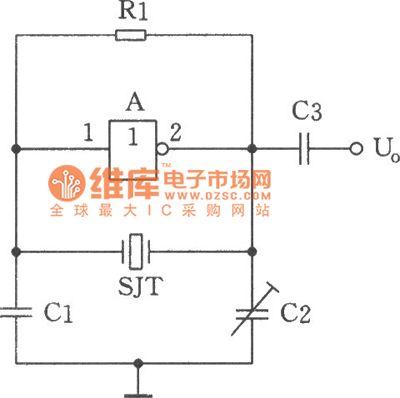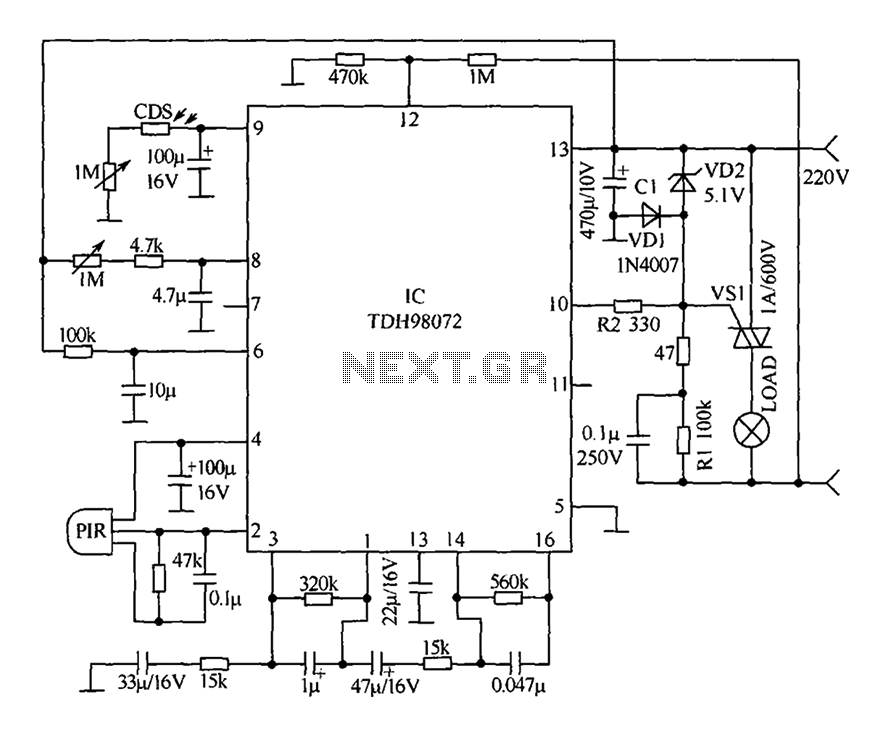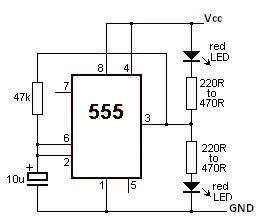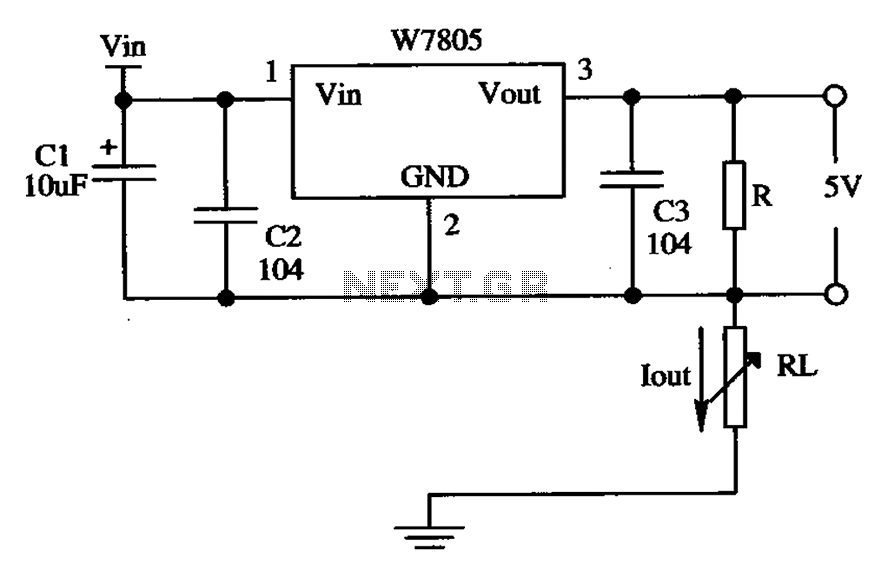
24V lead acid battery charger circuit
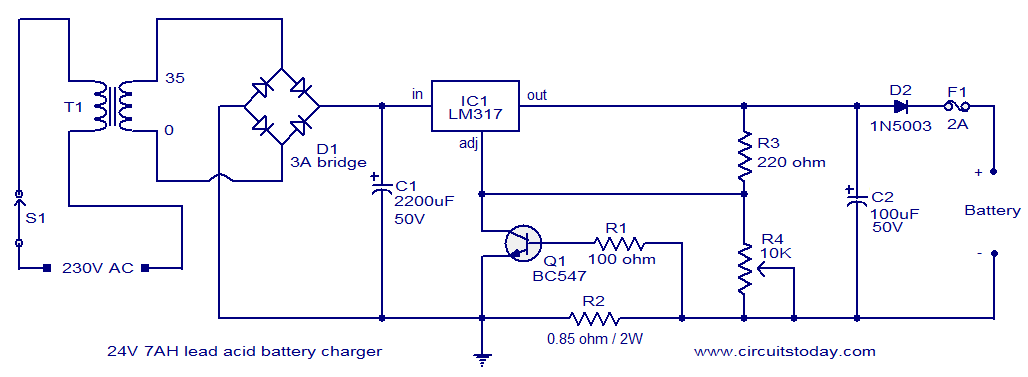
This lead-acid battery charger circuit is designed based on a request from Mr. Devdas C. His requirement was for a circuit that could charge two 12V/7AH lead-acid batteries connected in series. He did not specify the number of cells in each 12V battery, which is an important parameter; this design assumes each 12V battery contains 6 cells. When two batteries are connected in series, their voltages add up while the current capacity remains the same. Therefore, two 12V/7AH batteries in series can be treated as a 24V/7AH battery. The presented circuit is a current-limited lead-acid battery charger utilizing the well-known variable voltage regulator IC LM317. The charging current is determined by the value of resistor R2, which is set to 700mA. Resistor R3 and potentiometer R4 set the charging voltage. Transformer T1 reduces the mains voltage, while bridge rectifier D1 handles the rectification. Capacitor C1 acts as a filter capacitor. Diode D1 prevents reverse current flow from the battery when the charger is turned off or when mains power is unavailable. To set up the charging voltage, the charger should be powered on, and a voltmeter should be connected across the output terminals. Adjust R4 until the voltmeter reads 28V, indicating that the charger is ready for battery connection.
The lead-acid battery charger circuit operates by converting the AC mains voltage into a regulated DC output suitable for charging lead-acid batteries. The LM317 voltage regulator is pivotal in this circuit, providing adjustable output voltage and current limiting capabilities. The charging current, set at 700mA, is appropriate for maintaining the health and longevity of the batteries while preventing overcharging.
The transformer T1 is selected based on its secondary voltage rating, which must be sufficient to provide the required charging voltage after rectification and filtering. The bridge rectifier D1 converts the AC voltage to DC, and the filter capacitor C1 smooths the output, ensuring a steady voltage level for the batteries.
Resistor R3 is crucial for setting the voltage level, while the potentiometer R4 allows for fine adjustments to achieve the desired charging voltage of 28V, which is suitable for two 12V batteries in series. The inclusion of diode D1 is essential for protecting the circuit from back EMF generated by the batteries during disconnection or power loss.
This charger design emphasizes safety and efficiency, ensuring that the batteries are charged correctly while minimizing the risk of damage. Proper assembly and calibration of the circuit components will yield a reliable charging solution for lead-acid batteries, making it suitable for various applications where such batteries are utilized.This lead acid battery charger circuit is designed in response to a request from Mr. Devdas. C. His requirement was a circuit to charge two 12V/7AH lead acid batteries in series. Anyway he did not mentioned the no of cells per each 12V battery. The no of cells/battery is also an important parameter and here I designed the circuit assuming each 12V b attery containing 6 cells. When two batteries are connected in series, the voltage will add up and the current capacity remains same. So two 12V/7AH batteries connected in series can be considered as a 24V/7AH battery. The circuit given here is a current limited lead acid battery charger built around the famous variable voltage regulator IC LM 317.
The charging current depends on the value of resistor R2 and here it is set to be 700mA. Resistor R3 and POT R4 determines the charging voltage. Transformer T1 steps down the mains voltage and bridge D1 does the job of rectification. C1 is the filter capacitor. Diode D1 prevents the reverse flow of current from the battery when charger is switched OFF or when mains power is not available. To setup the charging voltage, power ON the charger and hook up a voltmeter across the output terminals and adjust R4 to make the voltmeter read 28V.
Now the charger is ready and you can connect the batteries. 🔗 External reference
The lead-acid battery charger circuit operates by converting the AC mains voltage into a regulated DC output suitable for charging lead-acid batteries. The LM317 voltage regulator is pivotal in this circuit, providing adjustable output voltage and current limiting capabilities. The charging current, set at 700mA, is appropriate for maintaining the health and longevity of the batteries while preventing overcharging.
The transformer T1 is selected based on its secondary voltage rating, which must be sufficient to provide the required charging voltage after rectification and filtering. The bridge rectifier D1 converts the AC voltage to DC, and the filter capacitor C1 smooths the output, ensuring a steady voltage level for the batteries.
Resistor R3 is crucial for setting the voltage level, while the potentiometer R4 allows for fine adjustments to achieve the desired charging voltage of 28V, which is suitable for two 12V batteries in series. The inclusion of diode D1 is essential for protecting the circuit from back EMF generated by the batteries during disconnection or power loss.
This charger design emphasizes safety and efficiency, ensuring that the batteries are charged correctly while minimizing the risk of damage. Proper assembly and calibration of the circuit components will yield a reliable charging solution for lead-acid batteries, making it suitable for various applications where such batteries are utilized.This lead acid battery charger circuit is designed in response to a request from Mr. Devdas. C. His requirement was a circuit to charge two 12V/7AH lead acid batteries in series. Anyway he did not mentioned the no of cells per each 12V battery. The no of cells/battery is also an important parameter and here I designed the circuit assuming each 12V b attery containing 6 cells. When two batteries are connected in series, the voltage will add up and the current capacity remains same. So two 12V/7AH batteries connected in series can be considered as a 24V/7AH battery. The circuit given here is a current limited lead acid battery charger built around the famous variable voltage regulator IC LM 317.
The charging current depends on the value of resistor R2 and here it is set to be 700mA. Resistor R3 and POT R4 determines the charging voltage. Transformer T1 steps down the mains voltage and bridge D1 does the job of rectification. C1 is the filter capacitor. Diode D1 prevents the reverse flow of current from the battery when charger is switched OFF or when mains power is not available. To setup the charging voltage, power ON the charger and hook up a voltmeter across the output terminals and adjust R4 to make the voltmeter read 28V.
Now the charger is ready and you can connect the batteries. 🔗 External reference
